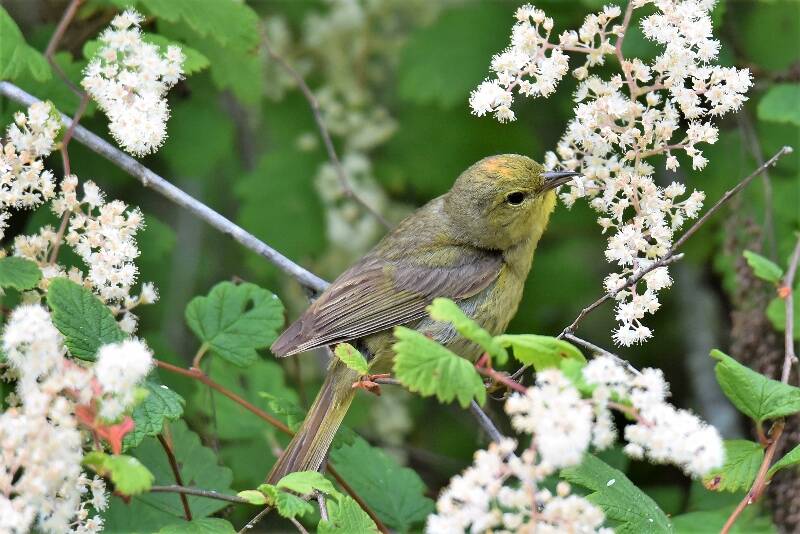Birds are a fabulous way to celebrate the Earth and its biodiversity.
Springtime’s dawn chorus, the flash of color in the woods, the drumming of a woodpecker — all of these manifestations of the birds among us underscore the wonder of the natural world and the vital role birds play in the fabric of our ecosystems. Our world is made richer by their presence.
But recent studies show that bird populations, especially songbirds, are in decline.
Leading organizations and government agencies are responding, working at the legislative level and on the ground to protect and restore habitat and advance policies that support ecosystem health. We, too, can help. In fact, without local action at our homes and in our communities,these large-scale strategies will not be enough.
With that in mind, here are recommendations from leading biologists and conservation organizations about what we as homeowners and landowners can do to support the birds that call Vashon Island home.
Keep cats indoors
Researchers estimate that outdoor cats kill more than a billion birds a year (the low end of the estimate) along with billions of native small mammals. Cat owners can reduce this staggering number by keeping cats indoors or in a secure “catio.” Keeping beloved pets indoors also keeps them out of danger from coyotes, eagles and other wild predators.
Make windows more visible to birds
After cats, collisions with windows are the second-leading cause of preventable death among birds. Suggestions for making your windows more bird-friendly can be found at the American Bird Conservancy, National Audubon Society, and other conservation organizations.
Reduce outdoor lighting
Unshielded or excessive outdoor lighting can distract and disorient birds during migration. Some evidence suggests that artificial lighting may also influence the behavior of breeding birds on and around their nests. Shielding lights so they illuminate where needed but not up into the sky or into the woods helps reduce these effects. Keeping lights off during the peaks of spring and fall migration helps birds find their way to their breeding grounds without distraction.
To find out more, go online.
Manage our land as if it matters to birds. Because it does!
Our rural lands and homescapes can be welcoming for birds if we provide or retain the habitat features they need. Besides food and shelter, birds need places to hide from predators, and breeding pairs need secure nest sites to raise their families. Growing or maintaining shrub thickets, piling brush instead of burning it and retaining dead logs and trees, where safe, are all ways to provide critical habitat features for our migratory friends, as well as for our year-round residents such as woodpeckers and chickadees.
It’s especially important to control invasive plants and maintain or restore native plant species. This can be challenging, but invasive species such as English holly and English ivy, if left unchecked, take over and change the very nature of our natural habitats.
All major conservation organizations stress the importance of native plants for birds, as well as for bees, butterflies and other wildlife. Reliable recommendations for native plants for our area can be found here.
Support groups working for bird-friendly policy
Land trusts and public agencies that protect and restore wildlife habitat and other organizations play a role in supporting bird populations. Habitat loss and degradation are leading causes of bird population declines. Land trusts and public agencies are skilled in identifying and protecting key places, such as rivers, streams and their bordering forests, and restoring them to good condition where necessary. By supporting them, we’re supporting wildlife of every kind, not just birds.
Other kinds of organizations also bring our collective energy and resources to conservation work far more effectively than each of us acting separately can do. They act as advocates in local councils and legislative bodies, provide funding for necessary research, create forums for sharing knowledge and facilitating public education and more — all critical in working towards the large-scale successes our far-ranging birds and wildlife need.
These recommendations are just a start. Our world is complex, and there’s not one simple prescription for how to protect birds or the ecosystems that support them.
But it’s important to recognize that we can and must do better. The choices we make about pets, outdoor lighting, our landscaping and our land management affect birds, either positively or negatively. By learning more and taking these relatively small steps, we can make a big difference for birds and wildlife.
Jim Evans, an ecologist, educator and Vashon resident, is a member of the Washington Native Plant Society and the Society for Ecological Restoration and serves on the board of the Vashon Bird Alliance.


